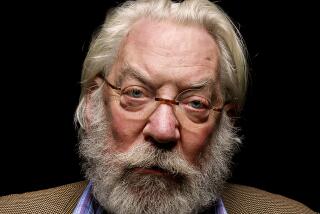They’re the Gunslinger Heroes Who Championed ‘Shane’
When George Stevens Jr. was a boy, he was enthralled with Jack Schaefer’s western novel “Shane”--so much so that he shared his excitement one evening with his father, Oscar-winning director George Stevens (“A Place in the Sun,” “Giant”).
“He was sitting in his bed at the house--I remember it so clearly--and he said, ‘Tell me the story,’ ” Stevens Jr. recalled recently. “I remember walking around his bed trying to tell him the story of ‘Shane.’ I saw it as a good yarn.”
But his father saw it as something more. When the elder Stevens decided to make “Shane” into a movie a few years later, “he as a filmmaker invested it with his own feelings and ideas,” says his son, who went on to become a writer, director and producer himself and founded the American Film Institute. The result was a classic.
Next Tuesday, Paramount is releasing a beautifully restored version of the 1953 film on DVD ($30), complete with the theatrical trailer and commentary from Stevens Jr. and associate producer Ivan Moffat.
And it’s truly a magical experience. Stevens’ direction, for which he received an Oscar nomination, is meticulous and imbued with humanism. And Loyal Griggs’ Oscar-winning Technicolor cinematography takes one’s breath away.
Alan Ladd gave the performance of his career as the mysterious Shane, a world-weary gunslinger who tries to settle down with a homestead family in Jackson Hole, Wyo. But he ends up forced to use his gun when conflict between the settlers and ranchers grows deadly.
Van Heflin plays the solid patriarch of the family, Joe Starrett, and Jean Arthur, in her last film role, is his wife, Marian. Brandon de Wilde, who was just 9, is perfection as Joey Starrett, their young son who idolizes Shane. And Jack Palance is terrifying as the evil gunslinger, Jack Wilson.
When “Shane” went into production in 1951, Stevens Jr. was 17 and worked on the film as the company clerk. “I had to write down every shot and every angle and every camera setup,” he recalls. “It was the first film [of my father’s] where I was on location and really had a job.”
Before World War II, Stevens had made his reputation by directing such comedies as “The More the Merrier,” “Swing Time” and “Woman of the Year” and action-adventures like “Gunga Din.” But his movies became more serious and introspective after his war experiences.
As leader of a battalion of camera crews, Army Lt. Col. Stevens hit the beach at Normandy to record the Allied invasion on D-day. He also witnessed Nazi atrocities when he was present at the liberation of the Dachau concentration camp.
When he returned home, he was shocked at the reckless portrayal of violence on screen. “He used to say, ‘John Wayne uses a six-gun like a guitar,’ ” Stevens Jr. says. “In westerns, people would shoot people and then they would get up and shoot back. He wanted, as he put it, to show [in “Shane”] what a single shell from a .45 can do to the human form.”
That, Stevens Jr. argues, was expressed beautifully in the film with the shooting of a homesteader played by Elisha Cook Jr.
“At that time, it was kind of unique,” Stevens Jr. says. “Westerns were just full of gunfire. Here was one where . . . guns were fired on just three occasions.”
*
The master prints of “Shane” and “A Place in the Sun” (1951), which was also produced by Paramount, had fallen into disrepair over the decades. “Several years ago, I learned that much of the original materials for ‘A Place in the Sun’ and ‘Shane’ were lost,” Stevens Jr. says.
“My father was one who used to say he was interested in how these films would be [perceived] in 25 years. Initially, I was so distressed that the material was missing. But through the wonders of modern technology and using the material we have had available to us, we have been able to restore the negatives and make a beautiful transfer.”
Stevens Jr. characterizes “Shane” as a film with “great storytelling and taste,” and he believes that audiences continue to identify with its humanistic morality tale, examining the battle between good and evil.
The movie’s three stars were not the first choices for the roles. Stevens Jr. and Moffat reveal on the audio track that Montgomery Clift was the original choice to play Shane, having just completed “A Place in the Sun” for Stevens, with William Holden to play Starrett. And there was talk of Katharine Hepburn as Marian, though Stevens Jr. believes a younger actress, Cathy O’Donnell, was being considered for the role. “It would have been totally different,” he says.
But when Clift dropped out--he ended up doing “From Here to Eternity”--Holden left the project. Stevens looked at the list of stars Paramount had under contract and chose Ladd, Heflin and Arthur, who hadn’t made a film in five years but had previously made “The More the Merrier” and “Talk of the Town” with Stevens.
Stevens didn’t rehearse his cast extensively before filming began. “Dad shot a lot of film,” says his son. “It gave him a lot of options in the cutting room. He was able to simplify performances and comb through the takes to find just the right reaction shots.”
In fact, says Stevens Jr., his father’s shooting style was a big joke around Hollywood. But there was a method to Stevens’ madness. “I remember him saying when we were editing ‘Giant’: ‘When you think about the number of man-hours that are going to be spent looking at this film, isn’t it sensible for us to spend more of our time making it as good as it can be?’ ”
More to Read
Only good movies
Get the Indie Focus newsletter, Mark Olsen's weekly guide to the world of cinema.
You may occasionally receive promotional content from the Los Angeles Times.











